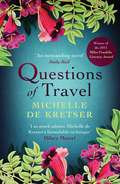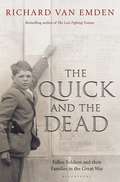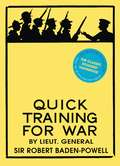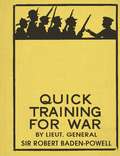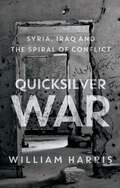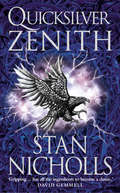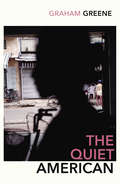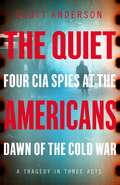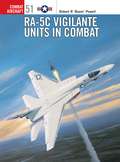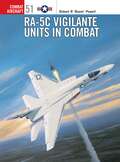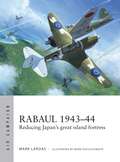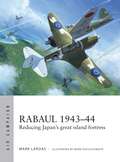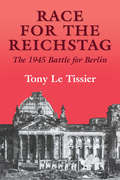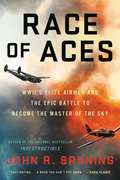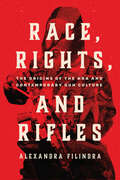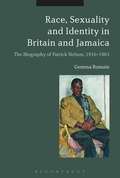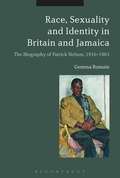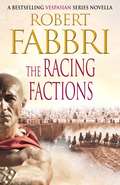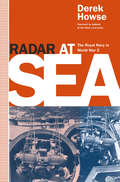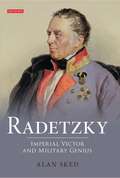- Table View
- List View
Questions and Answers on Immigration in Britain
by Farid Raymond AnthonyThis guide to immigration to Britain uses a question and answer format to provide information in simple English. It ranges over: visitors; professional workers; students; business people; working in the UK; settlement; asylum; offences and deportation; appeals and British nationality.
Questions and Answers on Immigration in Britain
by Farid Raymond AnthonyThis guide to immigration to Britain uses a question and answer format to provide information in simple English. It ranges over: visitors; professional workers; students; business people; working in the UK; settlement; asylum; offences and deportation; appeals and British nationality.
Questions of Travel: Winner of the 2013 Miles Franklin Award
by Michelle de KretserWinner of the 2013 Miles Franklin AwardWinner of the 2013 ALS Gold MedalLaura travels the world before returning to Sydney, where she works for a publisher of travel guides. Ravi dreams of being a tourist until he is driven from Sri Lanka by devastating events. An enthralling array of people, places and stories surround these superbly drawn characters - from Theo, whose life plays out in the long shadow of the past, to Hana, an Ethiopian woman determined to reinvent herself. Michelle de Kretser illuminates travel, work and modern dreams in this brilliant evocation of the way we live now. Questions of Travel is infused with wit, imagination, uncanny common sense and a deep understanding of what makes us tick.
The Quick and the Dead: Fallen Soldiers and Their Families in the Great War
by Richard Van EmdenAt the end of the First World War more than 192,000 wives had lost their husbands, and nearly 400,000 children had lost their fathers. A further half a million children had lost one or more siblings. Appallingly, one in eight wives died within a year of receiving news of their husband's death. Few people remained unscathed and the effects of the conflict are still with us. The Quick and the Dead will pay tribute to the families who were left to suffer at home while their husband, fathers and sons went off to fight, and the generations that followed.Through the stories in this groundbreaking history, we realise not just what became of our grandfathers but how their experiences influenced the children, grandchildren and great grandchildren of a generation that they left at home. Against all the odds some stories ended happily - missing fathers did return, men thought to be dead returned from prisoner of war camps to a joyous reunion. For others the loss, while difficult to bear at the time, gave them an independence, drive and ambition that ensured that their lives were successful and a fitting tribute to those who died.Very few people know that only the first minute's silence on Armistice Day is in memory of the dead of the Great War and all the subsequent wars. The second minute is for the living, the survivors of the war, and the wives and the children they left behind. Through a unique collection of over fifty interviews, private diaries and a remarkable collection of unpublished letters written by the soldiers to their families back home, The Quick and the Dead is a history of those who are commonly forgotten and neglected when the fallen are remembered on Armistice Day.
Quick Training for War
by Robert Baden-Powell Martin RobsonIn this fascinating little book, Baden-Powell uses his extensive military experience and memories of service in Africa to distill soldiering down to 'the four C-s': Courage, Common sense, Cunning and Cheerfulness. With observations gleaned from his campaigns against the Zulus, the Ashanti and the Boers during the period 1876–1910 (and even from conversations with the German Kaiser), B-P discusses all aspects of military service from digging trenches and earth-works to 'inculcating cheerfulness in your men'. This period document gives a unique insight into the mindset of the British officer in 1914; advocating a training system that encapsulated Edwardian values,conventional military thinking and centuries of army tradition. Quick Training For War is a perfect example of the type of war the British expected to fight and which they prepared for in 1914, and it became a standard survival guide for many British troops. Personable in tone, this is the well-intentioned, no-nonsense advice of a seasoned campaigner - albeit an officer more accustomed to scouting on the South African veldt than struggling through Somme mud.
Quick Training for War
by Robert Baden-Powell Martin RobsonIn this fascinating little book, Baden-Powell uses his extensive military experience and memories of service in Africa to distill soldiering down to 'the four C-s': Courage, Common sense, Cunning and Cheerfulness. With observations gleaned from his campaigns against the Zulus, the Ashanti and the Boers during the period 1876–1910 (and even from conversations with the German Kaiser), B-P discusses all aspects of military service from digging trenches and earth-works to 'inculcating cheerfulness in your men'. This period document gives a unique insight into the mindset of the British officer in 1914; advocating a training system that encapsulated Edwardian values,conventional military thinking and centuries of army tradition. Quick Training For War is a perfect example of the type of war the British expected to fight and which they prepared for in 1914, and it became a standard survival guide for many British troops. Personable in tone, this is the well-intentioned, no-nonsense advice of a seasoned campaigner - albeit an officer more accustomed to scouting on the South African veldt than struggling through Somme mud.
Quicksilver War: Syria, Iraq and the Spiral of Conflict
by William HarrisQuicksilver War is a panoramic political history of the wars that coursed through Syria and Iraq in the wake of the 'Arab Spring' and eventually merged to become a regional catastrophe: a kaleidoscopic and constantly shifting conflict involving many different parties and phases. William Harris distils the highly complex dynamics behind the conflict, starting with the brutalizing Baathist regimes in Damascus and Baghdad. He charts the malignant consequences of incompetent US occupation of Iraq and Bashar al-Assad's self-righteous mismanagement of Syria, through the implosion of Syria, and the emergence of eastern and western theatres of war focused respectively on future control of Syria and the challenge of ISIS. Beyond the immediate arena of conflict, geopolitical riptides have also been set in motion, including Turkey's embroilment in the war and the shifting circumstances of the Kurds. This sweeping history addresses urgent questions for our time. Will the world rubber-stamp and bankroll the Russian-led 'solution' in Syria, backed by Turkey and Iran? Is the 'Quicksilver War' about to reach an explosive finale? Or will ongoing political maneuvering mutate into years of further violence?
Quicksilver War: Syria, Iraq and the Spiral of Conflict
by William HarrisQuicksilver War is a panoramic political history of the wars that coursed through Syria and Iraq in the wake of the 'Arab Spring' and eventually merged to become a regional catastrophe: a kaleidoscopic and constantly shifting conflict involving many different parties and phases. William Harris distils the highly complex dynamics behind the conflict, starting with the brutalizing Baathist regimes in Damascus and Baghdad. He charts the malignant consequences of incompetent US occupation of Iraq and Bashar al-Assad's self-righteous mismanagement of Syria, through the implosion of Syria, and the emergence of eastern and western theatres of war focused respectively on future control of Syria and the challenge of ISIS. Beyond the immediate arena of conflict, geopolitical riptides have also been set in motion, including Turkey's embroilment in the war and the shifting circumstances of the Kurds. This sweeping history addresses urgent questions for our time. Will the world rubber-stamp and bankroll the Russian-led 'solution' in Syria, backed by Turkey and Iran? Is the 'Quicksilver War' about to reach an explosive finale? Or will ongoing political maneuvering mutate into years of further violence?
Quicksilver Zenith: Book Two Of The Quicksilver Trilogy (The Quicksilver Trilogy #2)
by Stan NichollsFrom the author of the internationally accalaimed Orcs series comes a powerful new epic fantasy to rival the work of Raymond E. Feist and David Gemmell.
The Quiet American: Discover Graham Green’s prescient political masterpiece (Virago Modern Classics #Vol. 11)
by Graham GreeneWITH AN INTRODUCTION BY ZADIE SMITHInto the intrigue and violence of Indo-China comes Pyle, a young idealistic American sent to promote democracy through a mysterious 'Third Force'. As his naive optimism starts to cause bloodshed, his friend Fowler, a cynical foreign correspondent, finds it hard to stand aside and watch. But even as he intervenes he wonders why: for the sake of politics, or for love?
The Quiet Americans: Four CIA Spies at the Dawn of the Cold War - A Tragedy in Three Acts
by Scott Anderson‘A darkly entertaining tale about American espionage, set in an era when Washington’s fear and skepticism about the agency resembles our climate today.’ New York Times At the end of World War II, the United States dominated the world militarily, economically, and in moral standing – seen as the victor over tyranny and a champion of freedom. But it was clear – to some – that the Soviet Union was already executing a plan to expand and foment revolution around the world. The American government’s strategy in response relied on the secret efforts of a newly-formed CIA. The Quiet Americans chronicles the exploits of four spies – Michael Burke, a charming former football star fallen on hard times, Frank Wisner, the scion of a wealthy Southern family, Peter Sichel, a sophisticated German Jew who escaped the Nazis, and Edward Lansdale, a brilliant ad executive. The four ran covert operations across the globe, trying to outwit the ruthless KGB in Berlin, parachuting commandos into Eastern Europe, plotting coups, and directing wars against Communist insurgents in Asia. But time and again their efforts went awry, thwarted by a combination of stupidity and ideological rigidity at the highest levels of the government – and more profoundly, the decision to abandon American ideals. By the mid-1950s, the Soviet Union had a stranglehold on Eastern Europe, the US had begun its disastrous intervention in Vietnam, and America, the beacon of democracy, was overthrowing democratically elected governments and earning the hatred of much of the world. All of this culminated in an act of betrayal and cowardice that would lock the Cold War into place for decades to come. Anderson brings to the telling of this story all the narrative brio, deep research, sceptical eye, and lively prose that made Lawrence in Arabia a major international bestseller. The intertwined lives of these men began in a common purpose of defending freedom, but the ravages of the Cold War led them to different fates. Two would quit the CIA in despair, stricken by the moral compromises they had to make; one became the archetype of the duplicitous and destructive American spy; and one would be so heartbroken he would take his own life. Scott Anderson’s The Quiet Americans is the story of these four men. It is also the story of how the United States, at the very pinnacle of its power, managed to permanently damage its moral standing in the world.
RA-5C Vigilante Units in Combat (Combat Aircraft)
by Jim Laurier Robert R PowellDeveloped from the A-5 nuclear bomber and used in a reconnaissance role, the RA-5C Vigilante was the largest and fastest aeroplane ever to operate from the deck of an aircraft carrier. During the Vietnam War it sustained the highest loss ratio of any American aircraft in that conflict. This volume includes compelling accounts of combat missions over key communist targets, where crews dodged Surface-to-Air Missiles (SAMs) and anti-aircraft fire to secure all-important mission photographs. Written by a Vigilante combat veteran this book is crammed full of action-packed first-hand accounts.
RA-5C Vigilante Units in Combat (Combat Aircraft)
by Robert R PowellDeveloped from the A-5 nuclear bomber and used in a reconnaissance role, the RA-5C Vigilante was the largest and fastest aeroplane ever to operate from the deck of an aircraft carrier. During the Vietnam War it sustained the highest loss ratio of any American aircraft in that conflict. This volume includes compelling accounts of combat missions over key communist targets, where crews dodged Surface-to-Air Missiles (SAMs) and anti-aircraft fire to secure all-important mission photographs. Written by a Vigilante combat veteran this book is crammed full of action-packed first-hand accounts.
Rabaul 1943-44: Reducing Japan's Great Island Fortress (Air Campaign Ser. #2)
by Mark LardasIn 1942, the massive Japanese naval base and airfield at Rabaul was a fortress standing in the Allies' path to Tokyo. It was impossible to seize Rabaul, or starve the 100,000-strong garrison out. Instead the US began an innovative, hard-fought two-year air campaign to draw its teeth, and allow them to bypass the island completely. The struggle decided more than the fate of Rabaul. If successful, the Allies would demonstrate a new form of warfare, where air power, with a judicious use of naval and land forces, would eliminate the need to occupy a ground objective in order to control it. As it turned out, the Siege of Rabaul proved to be more just than a successful demonstration of air power – it provided the roadmap for the rest of World War II in the Pacific.
Rabaul 1943–44: Reducing Japan's great island fortress (Air Campaign #2)
by Mark Lardas Mark PostlethwaiteIn 1942, the massive Japanese naval base and airfield at Rabaul was a fortress standing in the Allies' path to Tokyo. It was impossible to seize Rabaul, or starve the 100,000-strong garrison out. Instead the US began an innovative, hard-fought two-year air campaign to draw its teeth, and allow them to bypass the island completely. The struggle decided more than the fate of Rabaul. If successful, the Allies would demonstrate a new form of warfare, where air power, with a judicious use of naval and land forces, would eliminate the need to occupy a ground objective in order to control it. As it turned out, the Siege of Rabaul proved to be more just than a successful demonstration of air power – it provided the roadmap for the rest of World War II in the Pacific.
Race for the Reichstag: The 1945 Battle for Berlin (Soviet (Russian) Military Experience #No. 4)
by Tony, Le Tissier MBEThe soldiers of the Red Army identified the Reichstag as the victor's prize to be taken in Berlin. This account of the battle lays the many myths created by Soviet propaganda after the event to rest and details what exactly happened as the Red Army and the Allies raced to be the first at the Reichstag.
Race for the Reichstag: The 1945 Battle for Berlin (Soviet (Russian) Military Experience)
by Tony, Le Tissier MBEThe soldiers of the Red Army identified the Reichstag as the victor's prize to be taken in Berlin. This account of the battle lays the many myths created by Soviet propaganda after the event to rest and details what exactly happened as the Red Army and the Allies raced to be the first at the Reichstag.
Race of Aces: WWII's Elite Airmen and the Epic Battle to Become the Master of the Sky
by John R Bruning"Brings you into the cockpit of the lethal, fast-paced world of fighter pilots...Fascinating." -- Sara Vladic"Extraordinary...A must-read." -- US Navy Captain Dan Pedersen"A heart-pounding narrative of the courage, sacrifice, and tragedy of America's elite fighter pilots." -- James M. Scott"Vivid and gripping...Confirms Bruning's status as the premier war historian of the air." -- Saul DavidThe astonishing untold story of the WWII airmen who risked it all in the deadly race to become the greatest American fighter pilot. In 1942, America's deadliest fighter pilot, or "ace of aces" -- the legendary Eddie Rickenbacker -- offered a bottle of bourbon to the first U.S. fighter pilot to break his record of twenty-six enemy planes shot down. Seizing on the challenge to motivate his men, General George Kenney promoted what they would come to call the "race of aces" as a way of boosting the spirits of his war-weary command. What developed was a wild three-year sprint for fame and glory, and the chance to be called America's greatest fighter pilot. The story has never been told until now. Based on new research and full of revelations, John Bruning's brilliant, original book tells the story of how five American pilots contended for personal glory in the Pacific while leading Kenney's resurgent air force against the most formidable enemy America ever faced. The pilots -- Richard Bong, Tommy McGuire, Neel Kearby, Charles MacDonald and Gerald Johnson -- riveted the nation as they contended for Rickenbacker's crown. As their scores mounted, they transformed themselves from farm boys and aspiring dentists into artists of the modern dogfight. But as the race reached its climax, some of the pilots began to see how the spotlight warped their sense of duty. They emerged as leaders, beloved by their men as they chose selfless devotion over national accolades. Teeming with action all across the vast Pacific theater, Race of Aces is a fascinating exploration of the boundary between honorable duty, personal glory, and the complex landscape of the human heart.
Race, Rights, and Rifles: The Origins of the NRA and Contemporary Gun Culture (Chicago Studies in American Politics)
by Alexandra FilindraAn eye-opening examination of the ties between American gun culture and white male supremacy from the American Revolution to today. One-third of American adults—approximately 86 million people—own firearms. This is not just for protection or hunting. Although many associate gun-centric ideology with individualist and libertarian traditions in American political culture, Race, Rights, and Rifles shows that it rests on an equally old but different foundation. Instead, Alexandra Frilindra shows that American gun culture can be traced back to the American Revolution when republican notions of civic duty were fused with a belief in white male supremacy and a commitment to maintaining racial and gender hierarchies. Drawing on wide-ranging historical and contemporary evidence, Race, Rights, and Rifles traces how this ideology emerged during the Revolution and became embedded in America’s institutions, from state militias to the National Rifle Association (NRA). Utilizing original survey data, Filindra reveals how many White Americans —including those outside of the NRA’s direct orbit—embrace these beliefs, and as a result, they are more likely than other Americans to value gun rights over voting rights, embrace antidemocratic norms, and justify political violence.
Race, Sexuality and Identity in Britain and Jamaica: The Biography of Patrick Nelson, 1916-1963
by Gemma RomainThis is the first biography of the extraordinary, but ordinary life of, Patrick Nelson. His experiences touched on some of the most important and intriguing historical themes of the twentieth century. He was a black migrant to interwar Britain; an aristocrat's valet in rural Wales; a Black queer man in 1930s London; an artist's model; a law student, a recruit to the Auxiliary Military Pioneer Corps and Prisoner of War during the Second World War. Through his return to Jamaica after the war and his re-migrations to London in the late 1940s and the early 1960s, he was also witness to post-war Jamaican struggles and the independence movement as well as the development of London's post-war multi-ethnic migrations. Drawing on a range of archival materials including letters sent to individuals such as Bloomsbury group artist Duncan Grant (his former boyfriend and life-long friend), as well as paintings and newspaper articles, Gemma Romain explores the intersections of these diverse aspects of Nelson's life and demonstrates how such marginalized histories shed light on our understanding of broader historical themes such as Black LGBTQ history, Black British history in relation to the London artworld, the history of the Second World War, and histories of racism, colonialism and empire.
Race, Sexuality and Identity in Britain and Jamaica: The Biography of Patrick Nelson, 1916-1963
by Gemma RomainThis is the first biography of the extraordinary, but ordinary life of, Patrick Nelson. His experiences touched on some of the most important and intriguing historical themes of the twentieth century. He was a black migrant to interwar Britain; an aristocrat's valet in rural Wales; a Black queer man in 1930s London; an artist's model; a law student, a recruit to the Auxiliary Military Pioneer Corps and Prisoner of War during the Second World War. Through his return to Jamaica after the war and his re-migrations to London in the late 1940s and the early 1960s, he was also witness to post-war Jamaican struggles and the independence movement as well as the development of London's post-war multi-ethnic migrations. Drawing on a range of archival materials including letters sent to individuals such as Bloomsbury group artist Duncan Grant (his former boyfriend and life-long friend), as well as paintings and newspaper articles, Gemma Romain explores the intersections of these diverse aspects of Nelson's life and demonstrates how such marginalized histories shed light on our understanding of broader historical themes such as Black LGBTQ history, Black British history in relation to the London artworld, the history of the Second World War, and histories of racism, colonialism and empire.
The Racing Factions: A Crossroads Brotherhood Novella from the bestselling author of the VESPASIAN series (A Crossroads Brotherhood Novella #1)
by Robert FabbriAn ebook-exclusive short story from the bestselling Vespasian series.Marcus Salvius Magnus is a fanatical supporter of the Green Racing Faction and expects a wager to be honoured. Although he does not presume honesty from anyone, he does believe that a bookmaker at the Circus Maximus should record each bet scrupulously and pay the full amount due. But Ignatius, the bookmaker, is foolish enough to attempt to cheat Magnus out of his winnings, incurring not only his wrath but that also of the South Quirinal Crossroads Brotherhood of which Magnus is the leader. In the shady realm of Rome's underworld Magnus will use the full resources of his criminal fraternity to exact appropriate vengeance.But Magnus also has a problem: his patron, Gaius Vespasius Pollo, is attempting to get his nephew, Sabinus, elected as a quaestor. To do this he feels that the support of the senior consul, Gnaeus Domitius Ahenobarbus, would be more than useful. He asks Magnus to ease the consul - a man known for his extreme violence - in the right direction.Ahenobarbus has a passion: the Red Faction at the circus. Could it be that Magnus might wash two tunics in the same tub, bringing Ignatius down and securing Ahenobarbus' support by attempting to fix a chariot race in a manner that has never been done before?
Racing the Enemy: Stalin, Truman, and the Surrender of Japan
by Tsuyoshi HasegawaWith startling revelations, Tsuyoshi Hasegawa rewrites the standard history of the end of World War II in the Pacific. By fully integrating the three key actors in the story--the United States, the Soviet Union, and Japan--Hasegawa for the first time puts the last months of the war into international perspective. From April 1945, when Stalin broke the Soviet-Japanese Neutrality Pact and Harry Truman assumed the presidency, to the final Soviet military actions against Japan, Hasegawa brings to light the real reasons Japan surrendered. From Washington to Moscow to Tokyo and back again, he shows us a high-stakes diplomatic game as Truman and Stalin sought to outmaneuver each other in forcing Japan's surrender; as Stalin dangled mediation offers to Japan while secretly preparing to fight in the Pacific; as Tokyo peace advocates desperately tried to stave off a war party determined to mount a last-ditch defense; and as the Americans struggled to balance their competing interests of ending the war with Japan and preventing the Soviets from expanding into the Pacific. Authoritative and engrossing, Racing the Enemy puts the final days of World War II into a whole new light.
Radar at Sea: The Royal Navy in World War 2
by Derek HowseThis book tells in non-technical language how the British Navy contributed to the development of naval radar in World War 2. Addressed to the general reader, it tells not only the technical story in simple terms, but also of the operational use of shipborne radar at sea - for warning, for fire control, for fighter direction, for navigation, in all theatres of war - and particularly about the people who designed and fitted the equipment, and those who used it at sea.
Radetzky: Imperial Victor and Military Genius
by Alan SkedHistory remembers Wellington's defeat of Napoleon, but has forgotten the role of Field Marshal Radetzky in the battles which led to Napoleon's abdication and first exile in 1814. As Chief of Staff to the allied coalition of 1813-14, Radetzky determined the shape of the most decisive campaigns of the Napoleonic Wars by creating the strategy that defeated the Corsican in Germany and then France. Neither Russia nor Prussia had been able to overcome Napoleon in battle and it took the brilliant diplomacy of Metternich and the military genius of Radetzky to ensure victory over the Emperor. In short, the Austrian contribution decisively tipped the balance against Napoleon - a fact which has always been overlooked by historians. It was Radetzky, too, at the age of eighty-two, who defeated the Italians in 1848 and 1849 and thus saved Europe once again from the prospect of international war and revolution. The wars Radetzky fought - and won - throughout his extensive military career were of the greatest possible significance in European history, yet today, he is almost forgotten - remembered only in the music of the Radetzky March, dedicated to him by Johann Strauss the elder.In this, the first biography of Radetzky to be published in English, Alan Sked paints a vivid picture of an exceptional, yet neglected commander of genius in a book which will be fascinating reading for enthusiasts of military and modern European history.

